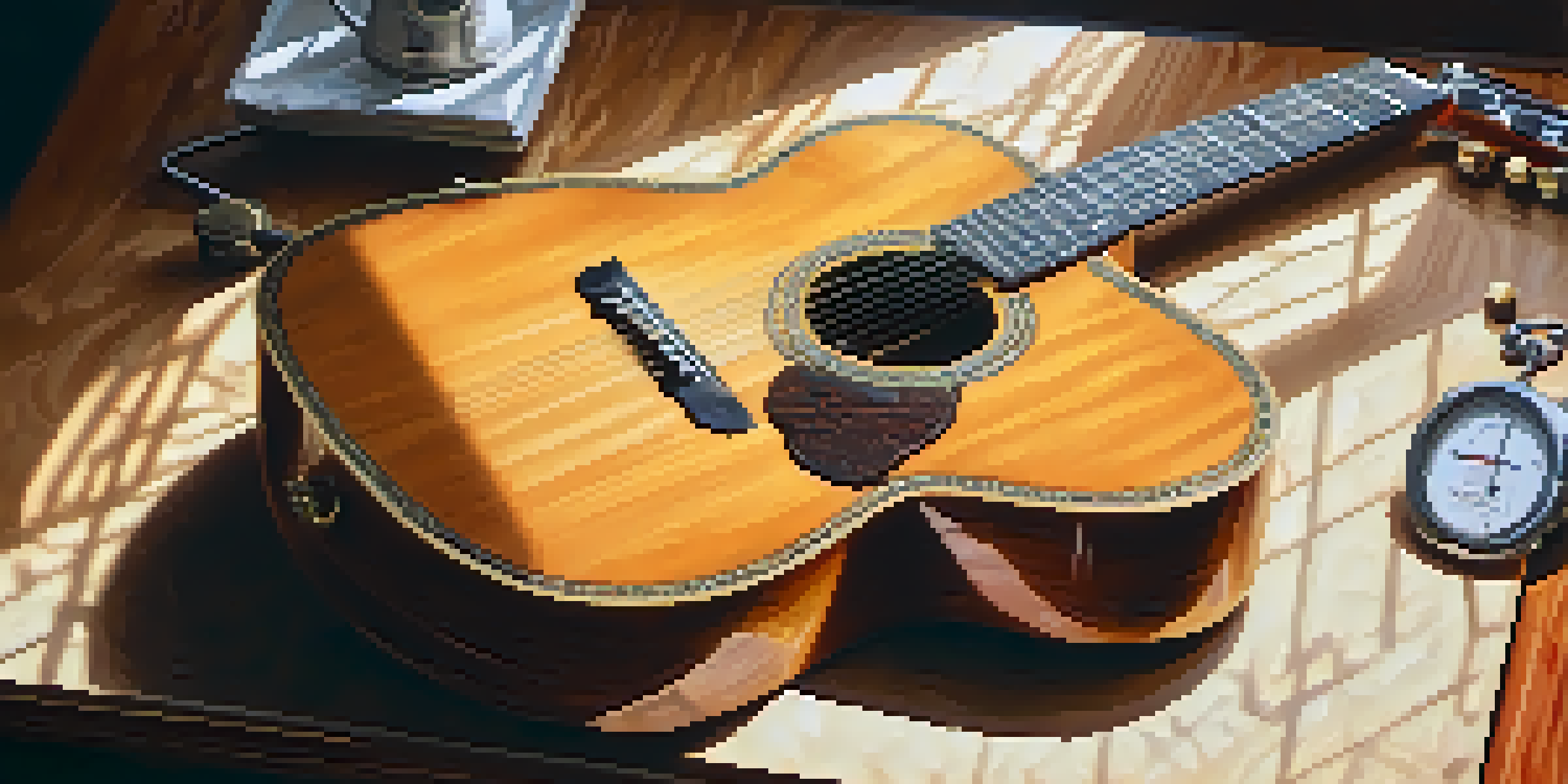Understanding Guitar Humidity: Keep Your Instrument Safe

What Is Guitar Humidity and Why Does It Matter?
Guitar humidity refers to the moisture content in the air surrounding your instrument. This level of moisture is crucial because guitars are made of wood, which can expand or contract based on the humidity levels. Just like how a sponge soaks up water, wood can absorb humidity, leading to potential damage over time.
The guitar is a miniature orchestra in itself.
Too much humidity can cause your guitar to swell, leading to issues like a raised fretboard or even cracks in the wood. Conversely, too little humidity can dry out your guitar, making it susceptible to warping and fret sprout. Understanding this balance is key to keeping your instrument in top condition.
Related Resource
In essence, maintaining the right humidity levels is an integral part of guitar care. It’s not just about playability; it’s about preserving the quality and longevity of your beloved instrument.
Ideal Humidity Levels for Guitars
The ideal humidity range for most guitars is between 40% and 60%. This sweet spot helps ensure that your guitar remains stable and retains its tone. Think of it like keeping your home at a comfortable temperature; too hot or too cold can lead to discomfort.

When humidity levels drop below 40%, it can negatively affect your guitar's wood, causing it to shrink and crack. On the flip side, exceeding 60% can lead to excessive moisture, resulting in mold growth and other issues. By keeping an eye on these levels, you can help prevent serious problems down the line.
Humidity Affects Guitar Health
Maintaining the right humidity levels is essential to prevent wood expansion, contraction, and potential damage to your guitar.
To monitor humidity, consider investing in a hygrometer, a handy tool that measures moisture levels in the air. This way, you’ll always know when it’s time to take action to protect your guitar.
Signs Your Guitar Is Experiencing Humidity Issues
Recognizing the signs of humidity issues can save your guitar from further damage. Look out for symptoms like buzzing frets, a warped neck, or cracks in the body. These are often telltale signs that your instrument is not in its ideal humidity range.
Wood is a material that breathes – it can expand and contract. It is essential to create the right environment for your instrument.
Another indicator could be changes in tone; if your guitar sounds dull or different than usual, it might be reacting to its environment. Additionally, keep an eye on the bridge and the fretboard; any changes here can signal that your guitar needs some humidity TLC.
Related Resource
If you notice any of these signs, it’s essential to act quickly. Addressing humidity issues sooner rather than later can prevent costly repairs and extend the life of your instrument.
How to Maintain Proper Humidity for Your Guitar
Keeping your guitar in a controlled environment is crucial for humidity management. Store it in a room with a stable climate, ideally away from windows and heating vents. Just like you wouldn’t leave a houseplant in direct sunlight all day, your guitar needs a consistent environment to thrive.
Consider using a humidifier during dry seasons or in arid climates. This can help maintain optimal humidity levels, ensuring your guitar remains safe from the damaging effects of dry air. Conversely, using a dehumidifier in overly humid conditions can also protect your instrument.
Ideal Humidity Range is Key
The optimal humidity range for guitars is between 40% and 60%, which helps preserve tone and structural integrity.
Another tip is to keep your guitar in its case when not in use. A quality case can act as a buffer against extreme changes in humidity, offering an additional layer of protection for your beloved instrument.
Using Humidity Control Products for Guitars
Humidity control products, like guitar humidifiers, are designed specifically to maintain the right moisture level inside your instrument's case. These products can be a lifesaver, especially for those living in areas with fluctuating humidity. Think of them as the personal trainers for your guitar's health!
There are various types of humidifiers available, from sponge-based to gel packs, each with its unique benefits. Some guitarists prefer using a sponge humidifier, which is easy to use and can be placed directly in the guitar's soundhole or case. Others may opt for a gel pack, which requires less maintenance and can provide consistent humidity levels.
Related Resource
Investing in a good humidifier is a small price to pay compared to the potential cost of repairs from neglecting humidity issues. It’s a proactive step towards preserving the quality and sound of your instrument.
Seasonal Changes and Their Impact on Guitar Humidity
As the seasons change, so do humidity levels, which can directly affect your guitar. During the winter months, heating systems tend to dry out the air, while summer can bring increased humidity. This ebb and flow can create a rollercoaster ride for your instrument if you're not careful.
Being aware of these seasonal changes allows you to take preventative measures. For example, in winter, you might need to use a humidifier more frequently, while summer might call for a dehumidifier to combat excess moisture. Just as you’d change your wardrobe with the seasons, your guitar’s care routine might need some adjustments too.
Monitor and Control Humidity
Using tools like hygrometers and humidifiers can effectively manage humidity levels and protect your guitar from damage.
By staying proactive and adjusting your humidity management strategy with the seasons, you can keep your guitar in peak condition year-round.
When to Consult a Professional for Humidity Issues
Sometimes, despite your best efforts, humidity issues can escalate. If you notice significant damage, such as cracks or severe warping, it's time to consult a professional luthier. They have the expertise to assess the damage and recommend the best course of action.
A professional can also provide valuable insights and tips tailored to your specific guitar model and playing style. They understand the nuances of different woods and construction methods, so their advice can be especially beneficial. Think of them as the doctors for your guitar!

Don’t hesitate to seek professional help; addressing issues sooner rather than later can save you both time and money in the long run. Proper care and timely intervention are key to ensuring your guitar remains a cherished companion for years to come.